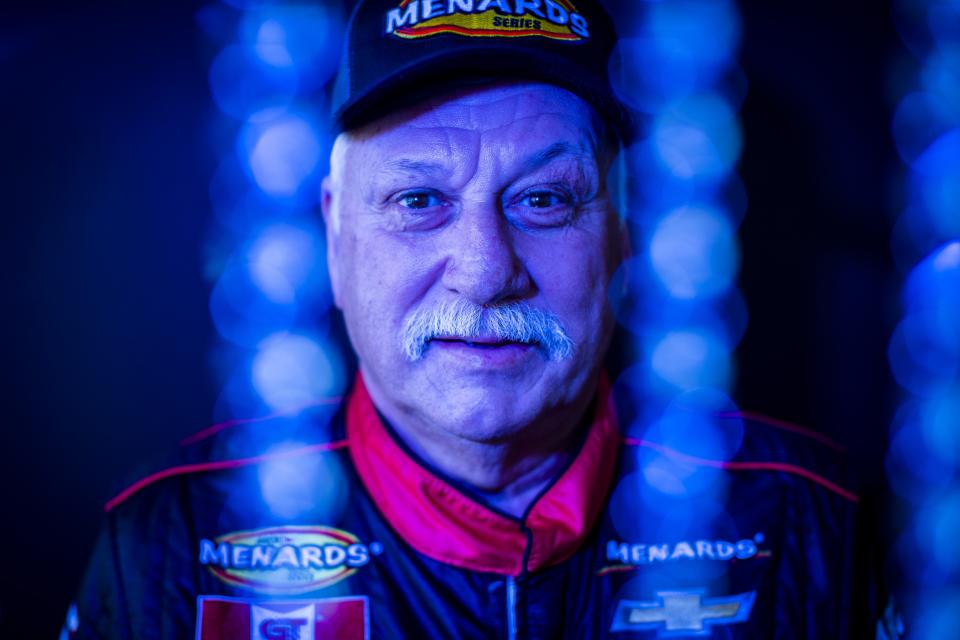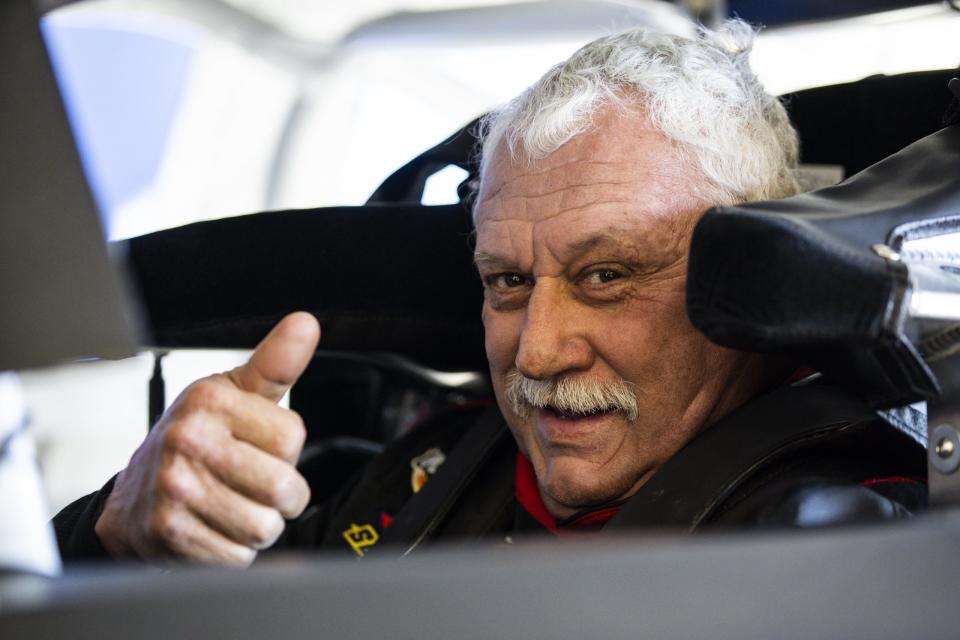Thirty years after One Hot Night, ARCA driver Dave Mader III proud of role in historic NASCAR event
- Oops!Something went wrong.Please try again later.
The night of May 16, 1992 was either going to feature one of NASCAR’s brightest moments or one of its dimmest.
Millions of dollars had been invested into a state-of-the-art system provided by Musco Lighting that would enable NASCAR and Charlotte Motor Speedway to host The Winston All-Star Race at night for the first time in its brief history.
The goal of this initiative was to give The Winston a jolt of popularity, but the concerns over being able to apply the concept of Saturday night short track racing onto a much larger scale persisted as the monumental event drew closer.
To ensure conditions at Charlotte would be safe to race at night, NASCAR and Charlotte turned to short track veteran Dave Mader III for a test run. Mader had qualified for The Winston that year by driving a car for Melling Racing that Bill Elliott had won in during the 1991 season.
Mader recalled being stunned at finding out that he would be the guinea pig determining the efficiency of the lights Musco had built for Charlotte.
“We were by our car and saw race director Dick Beaty coming our way with all the drivers,” Mader, now 66, told NASCAR.com. “Everyone surrounded the car, and Mr. Beaty said that since I was the most active night racer [at Charlotte], they wanted me to go around the track.
“I asked for [Dale Earnhardt] to go out, and everyone just started laughing.”
RESULTS: Full results from The 1992 Winston

Mader was among the many initial skeptics of former Charlotte track president Humpy Wheeler‘s plan to run The Winston at night.
Despite having accumulated numerous accomplishments during his short-track career that included four consecutive NASCAR All-American Challenge Series titles in the 1980s, racing on an intermediate track at night was something Mader thought was impossible, but he was still intrigued to see how the unique concept would be executed.
Anticipation quickly built for the 1992 Winston when the decision to run the race at night was announced in October of 1991. With only a few months at their disposal, Wheeler, Musco and Speedway Motorsports Inc. quickly went to work installing the Mirtran reflective-lighting systems around Charlotte.
Once everything was sorted out with the lights, a public test session was organized in April of 1992 that allowed more than 38,000 fans to see the best NASCAR Cup Series drivers make laps around Charlotte at night, with Mader being among those in attendance.
As day gradually transitioned into night, the apprehension in the garage area gradually rose as the drivers convened with Beaty to determine which of them would have the honor of formally breaking in a newly illuminated Charlotte track.
Gene Roberts, who was Mader‘s crew chief with Melling Racing at the time, said Earnhardt was the driving force behind convincing everyone that Mader was the perfect candidate to take those first nighttime laps.
“Nobody wanted to go around Charlotte that fast under the lights,” Roberts said. “I remember Dale Earnhardt looking over to Darrell Waltrip and saying to go get Dave Mader since he ran Saturday night shows all the time. They figured he would be more used to that kind of deal, and they wanted him to go out there first.”
With a little coercion from Roberts, Mader proceeded to climb into his No. 9 Maxx Race Cards Ford to make five laps around the track, all while Earnhardt, Waltrip, Davey Allison, Kyle Petty and the rest of the eligible drivers for The Winston carefully looked on.
Mader returned to an anxious pit road with a glowing review of the evening track conditions, providing his competitors all the confidence they needed to climb in their cars and fully commit to the idea of One Hot Night.
“I got out of the car, and Mr. Beaty asked what I thought,” Mader said. “I told him it was going to be fine, but the lights on the inside of the track were going to cast a shadow off the car closest to the bottom. Not even three minutes later, everyone was cranking up and pulling out on the track. We stood there wondering if that was the craziest thing we had ever seen.”
RACING REFERENCE: Career stats for Mader
With all concerns about the Winston quelled after the successful test session, a quick month passed before everyone returned to Charlotte for one of the most hyped events in NASCAR history at the time.
The mindset Mader had entering the weekend was the same as usual; to be the first driver across the finish line. But he knew immediately that the 1992 Winston was going to be much different than any race he had experienced once he stepped inside Charlotte.
For Roberts, the magnitude of the moment did not really set in until he helped push Mader‘s car out onto the frontstretch for pre-race ceremonies.
“That place was standing room only,” Roberts said. “None of us had ever been that close to a crowd that big. They were only about 40 feet away from the bottom edge of the track, and it was absolutely scary for me. These people are shouting, screaming and hanging on the fence. You could literally feel the vibration off the crowd.”
RACING REFERENCE: Crew chief stats for Roberts

Roberts could not take in the energetic atmosphere in the grandstands for long, as he had to turn his attention back toward the car to make sure Mader remained competitive through the 70-lap race after qualifying 12th.
The first segment for Mader was all about building confidence. Although he fell to the rear of the lead-lap cars, Mader felt the car provided by Roberts and his Melling Racing crew was still strong enough to contend for a top 10.
That confidence was tested when Mader found himself on the outside of the front row for Segment 2 after the invert, a challenge that the short track veteran took in stride.
“It wasn‘t any different from any other restart I‘ve been a part of,” Mader said. “I grew up racing the Allisons, Neil Bonnett, Red Farmer, Freddie Fryar, Darrell Waltrip and many more, so I was never intimidated by Dale Sr., Richard Petty or anyone else. It was exciting, but I just wasn‘t aggressive enough.”
Mader admitted that if given another chance to redo the second segment restart, he would not have been as cautious while racing leader Geoff Bodine to put himself in a more ideal position for the final 10-lap shootout.
Instead, Mader gradually dropped back through the pack until the end of the second segment. His night ultimately came to an end four laps from the finish after a tight battle with Harry Gant resulted in Mader‘s car bouncing off the outside retaining wall in Turn 4.
As soon as Mader climbed out of his car, he had a front-row seat to the now-iconic finish that saw Kyle Petty turn Allison into the outside retaining wall while trying to reach the checkered flag first.
Like everyone else in attendance that night, Mader was concerned Allison had been seriously injured in the crash. Finding out that Allison had suffered a broken collarbone and a few bruises came as a major relief for Mader after seeing and hearing the driver‘s side impact he took into the wall.
“All of that happened right in front of where we were pitted,” Mader said. “It was really horrible, and Davey was so lucky to live through that. The impact was awful, and the fact that he survived was really a testament to the cars and the helmets.”
Once the chaos of the final lap and its aftermath settled, Mader was thrilled to see his long-time friend Larry McReynolds share the honor of winning NASCAR‘s first All-Star event at night with Allison. The victory continued a hectic-but-successful season for the duo that saw them win five races and finish third in the Cup Series point standings.
Mader and Roberts would not be as fortunate after the 1992 Winston. The partnership between them at Melling Racing only lasted until the following weekend in the Coca-Cola 600 before Mader was replaced by Chad Little for the rest of the season.
Three decades have passed since that night, and the two are still heavily occupied with motorsports. Mader drives part-time in the ARCA Menards Series and competes in weekly races down south, while Roberts takes part in vintage racing back in his home state of Georgia.

Roberts says he knew NASCAR was undergoing a monumental culture change with the 1992 Winston and anticipated that several other tracks would quickly follow Charlotte‘s lead and install their own lighting systems over the next few years.
“It was a time-changer,” Roberts said. “NASCAR has been in a cutting-edge mode for a long time now, and they were really trying to up their game. We could see that changing of the guard when it came to how people wanted to view NASCAR. For me, it was a spectacular night even though we didn‘t get to compete where we wanted to.”
Roberts‘ prediction soon came to fruition, as many historic NASCAR tracks like Daytona International Speedway, Martinsville Speedway and more have all hosted night races since the 1992 Winston.
While Mader knew nothing was stopping NASCAR from reaching their night racing ambitions, he considers himself honored that the sanctioning body trusted his experience and input when it came time to put Musco‘s system to the test, kickstarting a new era for the sport.
Making those first nighttime laps around Charlotte remains one of the proudest moments of Mader‘s long career.
“This is right behind winning the Snowball Derby in 1978,” Mader said. “I‘ve never started a Daytona 500, and [the 1992 Winston] was even bigger than that. I got to experience it firsthand, and I still love talking about it. I didn‘t realize what it meant to make those first laps until many years later, and it‘s so cool to be someone who has done something significant in NASCAR.”
Even though Mader‘s impact on the 1992 Winston was small, those initial laps he made around Charlotte during that April test session helped cement One Hot Night as a significant and cherished part of NASCAR lore still fondly remembered 30 years onward.

